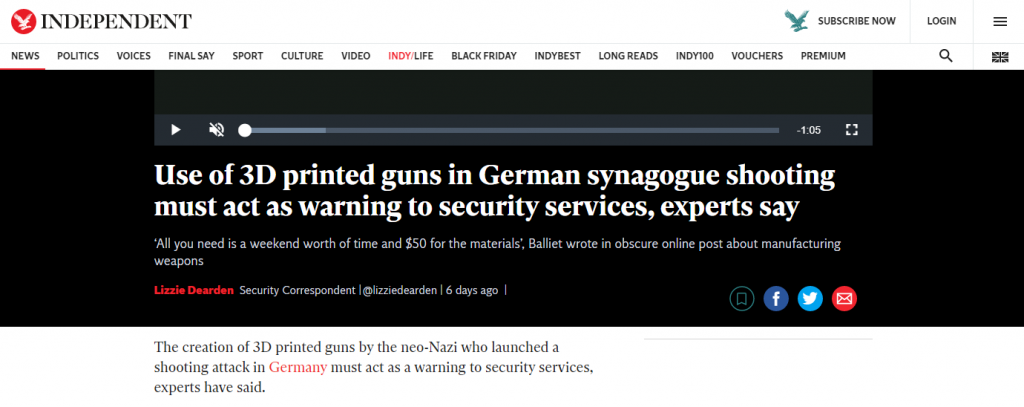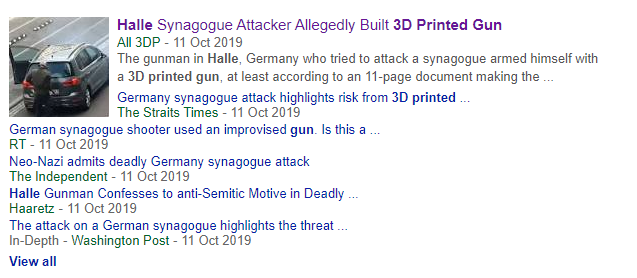Widespread media coverage of the recent attack on a synagogue in Halle, Germany, reported that the gunman responsible was wielding a 3D printed gun. An incredibly abhorrent attack, taking the lives of two people and injuring others, the claims have not gone unnoticed by the 3D printing industry. As cases of this nature are so often sensationalized, and inaccurately reported due to a lack of understanding, we took it upon ourselves to look behind the headlines.

I spoke with researchers at the International Centre for the Study of Radicalisation (ICSR) at King’s College London. The team here seeks “to bring an empirical understanding to the study of international security and terrorism issues,” and have seen the mission statement, documentation relating to weapon manufacture, and footage recorded by the assailant of the Halle attack.
Putting it simply: a 3D printed gun was not used in the murder of these people.
The official comment from the ICSR says that “The attacker constructed several weapons – some more than others involved 3D printing. However, none of his weapons were entirely 3D printed.”
3D printed components used in the design were non-critical to the operation of the firearms, and can also be readily purchased online.

The attack happened Wednesday 9 October, the date marking the end of Yom Kippur. The gunman had several homemade weapons in his possession at the time of attack, though only two of them were actually used. The first of these was the so-called “Luty” submachine gun, named after the late Philip Luty who is responsible for creating and distributing the design files for the weapon online. The ICSR told me that the Luty is the weapon that the attacker used to murder his two victims. It was made mostly from steel and not using a 3D printer. 3D printed, non-metal elements incorporated into the gunman’s Luty design were the trigger clip and torch barrel attachment, though ICSR researchers add that “The gun would have been operational without those 3D printed elements.” In addition, both of the parts can be readily and cheaply bought online in their conventionally manufactured forms.
The second gun used by the assailant was a shotgun with a 3D printed shell holder attached. Again the 3D printed component was not essential for the gun’s operation. Metal versions of the part can be bought online, and there are video tutorials about how to make the parts on consumer-grade CNC mills.
The assailant moved onto a second weapon due to cartridges jamming inside the gun. Around this point, the gunman is quoted as calling himself a “loser,” saying “I have certainly managed to prove how absurd improvised weapons are,” a point that has been seemingly echoed by the extremist group he was a part of.
“For what it’s worth, I think his attack – and his stated aim of proving the viability of homemade improvised weapons – will come to be seen as a “failure” within the far-right extremist milieu,” said our source at the ICSR, explaining: “When there’s an “innovation” in attack planning (e.g. the use of a vehicle to run people over, or the use of 3D printed elements), we see that terrorists often mimic those innovations that are “successful” (measured in media impact and/or number of casualties). So following on from the 2016 Nice attack (which involved the use of a truck to run people over), we saw an uptick in plots that used vehicles to run people over.”
“Given that this attack wasn’t “successful” (judging from the reaction of white nationalists online), it may not prove to be the breakthrough attack that announces 3D printed weapons as viable to an audience of future attackers.”
In order to prevent such attacks in the future, the ICSR maintains that “There obviously needs to be regulation and measures to restrict the fabrication of weapons in this way.” However, how exactly to go about regulating the digital nature of these elements remains unclear. The ICSR adds, “It’s difficult, as people have been making improvised weapons for centuries/millennia.”
Learn more about the ICSR’s work here.
For further news from 3D Printing Industry, subscribe to our newsletter.
Featured image shows a photo of the 3D printed “Liberator” handgun. Original photo via Defense Distributed



